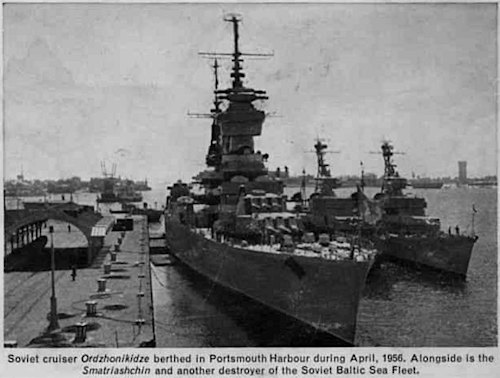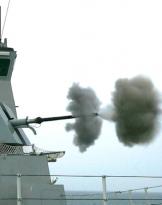There are characters of the sea who have lived an adventurous life, leaving behind them an aura of mystery. Today we try to tell the story of Commander Lionel Crabb, a pioneer of British military diving during the Second World War, who mysteriously disappeared during the Cold War.
I used the verb "to try" because his life is still shrouded in mystery and culminating, as in one spy story, with his alleged disappearance in the freezing waters of an English port.
A reckless life
Crabb was born in 1909 in a neighborhood in southwest London to a family that certainly did not sail in gold. He enlisted in the Merchant Navy and then in the Royal Navy Voluntary Reserve before World War II.
Curiously at the beginning of the war he was drafted as an army gunner but, in 1941, he joined the British Navy where he was employed in a mine clearance unit.
The Italians had just carried out an attack by releasing underwater charges (limpet mines) under the hulls of the ships and the British had not the faintest idea of how to counter them. Crabb's job was to disarm the charges removed by British divers, a dangerous job that gave him adrenaline. Following contact with those men who plunged into the waters to hunt for bombs, Crabb decided to learn to dive. He succeeded very well.
These divers employed a modified version of the Davis oxygen self-contained breathing apparatus which was used in an emergency to escape from submarines. The name frogman, which had been given to them, probably depended on the fact that these operators swam only breaststroke, without fins.

In December 1942, during an attack on Gibraltar, two Italian gamma divers, Lieutenant Visintini and the non-commissioned officer Magro, died from explosive charges thrown into the sea by the surveillance boats at the breakwaters. Their bodies were recovered with equipment (including fins) which were later adopted by Lionel Crabb.
The Royal Navy had, at the same time, established a special team of divers, theUnderwater Working Party (UWWP), under the command of Lt. Bill Bailey, with the task of inspecting the hulls of boats for explosive devices and removing them. Thus began Operation TADPOLE, a set of prevention and counter tactics against the attacks of the X MAS Flotilla in the port of Gibraltar and its vicinity. History tells us that it was not very effective and the Italians continued to strike and sink the British shipping ...
However, Crabb distinguished himself for his valor and was promoted to lieutenant captain. In 1943 it became diving first officer for Northern Italy, and was assigned for the demining of the ports of Livorno and Venice, receiving the decoration of officer of the Order of the British Empire for these services.
He was also sent to investigate the suspicious death of General Sikorski of the Polish army, whose B-24 aircraft Liberator it crashed near Gibraltar in 1943. He sought in vain the collaboration of many Italian Gamma veterans including Luigi Ferraro, whom he asked to continue the war with the British against the Japanese.
At that time Crabb had earned the nickname "Buster", named after the American actor and swimmer Buster Crabbe, a nickname which from then on accompanied him throughout his life.
 After the war, Crabb was sent to Palestine to lead a team of deactivating divers to clear some explosive charges that had been laid by divers of the Palmach irregular force during the Mandatory Palestine years.
After the war, Crabb was sent to Palestine to lead a team of deactivating divers to clear some explosive charges that had been laid by divers of the Palmach irregular force during the Mandatory Palestine years.
In 1947 he was unofficially discharged and began to work in the civil field as a diver, making use of his experience gained in the army.
In the 50s he was involved by the British Navy in the search for the wreck of an elusive Spanish Armada galleon, which was said to have sunk in the waters of Tobermory, near the Isle of Mull.
He also collaborated in the search for survivors in the tragic accidents of the submarine HMS earthy in January 1950 and the HMS affray in 1951. He then devoted himself to various jobs, transporting goods to the shops and, perhaps, it was during one of those trips that he found his friend a diver and companion in the war, Sydney Knowles.
In 1955, at the request of the British Royal Navy, they plunged together in a covert operation to investigate the hull of the Soviet cruiser. Sverdlov. According to Knowles, during the dive, they found a circular opening in the bow of the ship with a large propeller inside that could be directed to orient the ship (a thruster).
We were in the midst of the Cold War, that historical period that saw NATO on one side and the Warsaw Pact forces on the other, and espionage activities were still centered on the human element on both sides. It is no coincidence that the writer Ian Fleming, also with a background as a spy, wrote his best novels focusing on the figure of James Bond (also a lieutenant commander like Crabb) recounting impossible missions against Soviet spies and international criminal organizations. For Commander Lionel Crabb it was the last mission for the Royal Navy which he had always served with dedication and courage; that same year, in March 1955, Lionel Crabb was forced to permanently retire due to age restrictions.
But could it end like this or was it a facade dismissal? The question that many still ask is whether he was later recruited by MI6
At this point the story gets complicated. Given your uncommon experience, was he really enlisted by MI6? It certainly wasn't easy. His experience in underwater occult operations was invaluable but drinking and too much smoking often put his health in jeopardy. His partner Pat told reporters that they often fought over hers "… Too much smoking, drinking excessively in its 44 years 'old and sick'…".
 His spirit of adventure probably didn't stop him. At this point the various journalistic sources speculate that his contacts with MI6 did not cease and, in 1956, Lionel Crabb was sent to investigate the Soviet cruiser. Ordzhonikidze, which had transported Nikita Khrushchev and Nikolai Bulganin on a very delicate diplomatic mission to Great Britain.
His spirit of adventure probably didn't stop him. At this point the various journalistic sources speculate that his contacts with MI6 did not cease and, in 1956, Lionel Crabb was sent to investigate the Soviet cruiser. Ordzhonikidze, which had transported Nikita Khrushchev and Nikolai Bulganin on a very delicate diplomatic mission to Great Britain.
It was the night of April 19, 1956; Crabb dived into the freezing waters of Portsmouth Harbor but did not come back. All his belongings disappeared from the Sally Port Hotel where he was staying and even the page of the hotel register with his name was torn off.
Ten days later, British newspapers published Crabb's disappearance on an underwater training mission. The British Admiralty announced that lieutenant commander Lionel Crabb had disappeared while participating in the testing of new underwater equipment at Stokes Bay on the Solent.
The Soviets responded by issuing a vague statement stating that the crew of Ordzhonikidze he had seen a diver near the cruiser on April 19.
From that moment many hypotheses arose
Some British newspapers speculated that the Soviets had captured him during his action and later brought him to the Soviet Union. In fact, after about 14 months, on June 9, 1957, a corpse with a dry suit similar to the one used by Lionel Crabb was recovered in a fishing net off the island of Pilsey, in the port of Chichester. The body was missing its head and both hands which made identification impossible (DNA testing was not yet possible).
The investigation was opened on 11 June 1957 but neither friend of many adventures Sydney Knowles nor Crabb's ex-wife nor Crabb's other friends were able to recognize his body.

Partial declassifications
As some information was made public (under the 50-year rule) new facts about Crabb's disappearance have emerged. On October 27, 2006, the National Archives published documents relating to the mission under the hull of the Ordzhonikidze. But not only. Sydney Knowles, Crabb's former diving partner, stated in a television interview (Inside Out - South of January 19, 2007) that Crabb did not dive alone in his last mission, indeed in those waters there were others with him.
There was also a statement from a former Russian diver named Koltsov, who reported that he was ordered to dive to investigate suspicious activity around the cruiser. Ordzhonikidze. Plausible considering that the ship had transported President Khrushchev and Prime Minister Bulganin, for meetings with British Prime Minister Sir Anthony Eden and his ministers, security must have been maximum on both sides.
What seems strange is that surely the Russian ship was under surveillance and that the dive of a diver from it would certainly have been noticed by the British. Koltsov revealed to Russian reporters that he dived that night in Portsmouth Harbor, where theOrdzhonikidze it was moored, and which, during its inspection, had discovered "the shape of a diver" fumbling on the starboard side of the ship, below the waterline, right at the ship's ammunition depots. As he approached, he realized that "he was placing a mine on the hull". Koltsov walked over and got the better of the diver by slitting his throat.
Truth or fantasy?
Perhaps we will find out in 2057 when some British government documents, still secret, will be made public.
What is the Russian version? Apart from Kolstov's statement, there are many unanswered questions. In fact, some sources report that after the Crabb "accident" the Soviets created the PDSS (Противо-Диверсионные Силы и Средства, Protivo-Diversionnyye Sily i Sredstva = Forces and anti-sabotage means), in the structures of the Soviet fleet Black Sea. The PDSS had the task of countering attacks by enemy divers with special teams chosen from among the Spetnaz.
In those years many other theories came out according to which Lionel Crabb had to emerge due to a malfunction of his oxygen system and was killed by a sentry or just wounded. In that case the story goes beyond Ian Fleming's novels. Crabb, they said, was captured by the Soviets who then secretly transported him to Russia where he perhaps betrayed his country. Others think that he simply fell ill and, after being recovered by the Russians, was made to disappear by them to avoid the political embarrassment that would have resulted in such a delicate historical moment.
A story that has attracted journalists, historians and novelists but has now vanished into thin air, like the smoke of the inevitable "Buster" Crabb cigarettes.
(article originally published on http://www.ocean4future.org)
Photo: Imperial War Museums / web / British Pathé












